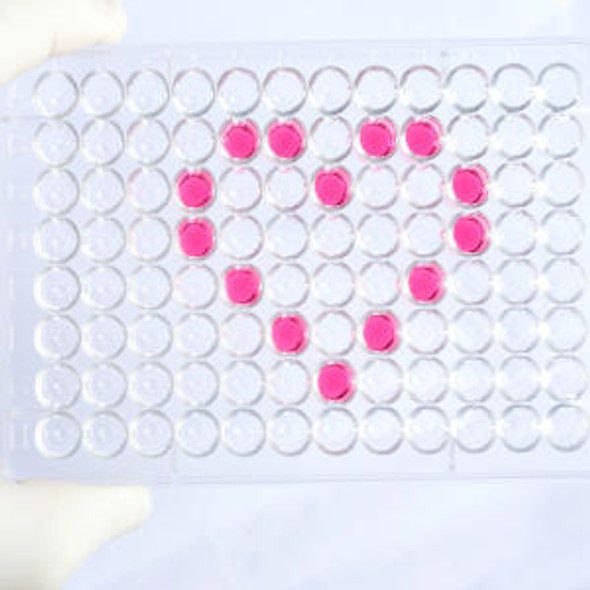Rat Poly [ADP-ribose] polymerase 1 (Parp1) ELISA Kit (RTEB0521)
- SKU:
- RTEB0521
- Product Type:
- ELISA Kit
- Size:
- 96 Assays
- Uniprot:
- P27008
- Range:
- 78-5000 pg/mL
- ELISA Type:
- Sandwich
- Synonyms:
- Parp1, ADPRT, PPOL, Poly [ADP-ribose] polymerase 1, PARP-1, Poly[ADP-ribose] synthase 1, ADPRT 1
- Reactivity:
- Rat
Description
Rat Poly [ADP-ribose] polymerase 1 (Parp1) ELISA Kit
The Rat PARP1 (Poly ADP-Ribose Polymerase 1) ELISA Kit is a reliable and accurate tool for the detection of PARP1 levels in rat serum, plasma, and cell culture supernatants. With high sensitivity and specificity, this kit provides precise and reproducible results, making it suitable for a wide range of research applications.PARP1 is a key enzyme involved in DNA repair and cell survival processes. Dysregulation of PARP1 has been linked to various diseases, including cancer, inflammatory disorders, and neurodegenerative conditions.
Therefore, the Rat PARP1 ELISA Kit is an essential tool for studying the role of PARP1 in these diseases and developing potential therapeutic strategies.Overall, the Rat PARP1 ELISA Kit offers researchers a valuable tool for investigating the role of PARP1 in disease pathology and developing targeted interventions for improved patient outcomes.
| Product Name: | Rat Poly [ADP-ribose] polymerase 1 (Parp1) ELISA Kit |
| SKU: | RTEB0521 |
| Size: | 96T |
| Target: | Rat Poly [ADP-ribose] polymerase 1 (Parp1) |
| Synonyms: | ADP-ribosyltransferase diphtheria toxin-like 1, DNA ADP-ribosyltransferase PARP1, NAD(+) ADP-ribosyltransferase 1, Poly[ADP-ribose] synthase 1, Protein poly-ADP-ribosyltransferase PARP1, ARTD1, ADPRT 1, PARP-1, Adprt |
| Assay Type: | Sandwich |
| Detection Method: | ELISA |
| Reactivity: | Rat |
| Detection Range: | 78-5000pg/mL |
| Sensitivity: | 39.4pg/mL |
| Intra CV: | 5.3% | ||||||||||||||||||||
| Inter CV: | 9.8% | ||||||||||||||||||||
| Linearity: |
| ||||||||||||||||||||
| Recovery: |
| ||||||||||||||||||||
| Function: | Poly-ADP-ribosyltransferase that mediates poly-ADP-ribosylation of proteins and plays a key role in DNA repair. Mainly mediates glutamate and aspartate ADP-ribosylation of target proteins: the ADP-D-ribosyl group of NAD(+) is transferred to the acceptor carboxyl group of glutamate and aspartate residues and further ADP-ribosyl groups are transferred to the 2'-position of the terminal adenosine moiety, building up a polymer with an average chain length of 20-30 units. Mediates the poly(ADP-ribosyl)ation of a number of proteins, including itself, APLF and CHFR. Also mediates serine ADP-ribosylation of target proteins following interaction with HPF1; HPF1 conferring serine specificity. Probably also catalyzes tyrosine ADP-ribosylation of target proteins following interaction with HPF1. Catalyzes the poly-ADP-ribosylation of histones in a HPF1-dependent manner. Involved in the base excision repair (BER) pathway by catalyzing the poly-ADP-ribosylation of a limited number of acceptor proteins involved in chromatin architecture and in DNA metabolism. ADP-ribosylation follows DNA damage and appears as an obligatory step in a detection/signaling pathway leading to the reparation of DNA strand breaks. In addition to base excision repair (BER) pathway, also involved in double-strand breaks (DSBs) repair: together with TIMELESS, accumulates at DNA damage sites and promotes homologous recombination repair by mediating poly-ADP-ribosylation. In addition to proteins, also able to ADP-ribosylate DNA: catalyzes ADP-ribosylation of DNA strand break termini containing terminal phosphates and a 2'-OH group in single- and double-stranded DNA, respectively. Required for PARP9 and DTX3L recruitment to DNA damage sites. PARP1-dependent PARP9-DTX3L-mediated ubiquitination promotes the rapid and specific recruitment of 53BP1/TP53BP1, UIMC1/RAP80, and BRCA1 to DNA damage sites. Acts as a regulator of transcription: positively regulates the transcription of MTUS1 and negatively regulates the transcription of MTUS2/TIP150. With EEF1A1 and TXK, forms a complex that acts as a T-helper 1 (Th1) cell-specific transcription factor and binds the promoter of IFN-gamma to directly regulate its transcription, and is thus involved importantly in Th1 cytokine production. Involved in the synthesis of ATP in the nucleus, together with NMNAT1, PARG and NUDT5. Nuclear ATP generation is required for extensive chromatin remodeling events that are energy-consuming. |
| Uniprot: | P27008 |
| Sample Type: | Serum, plasma, tissue homogenates, cell culture supernates and other biological fluids |
| Specificity: | Natural and recombinant rat Poly [ADP-ribose] polymerase 1 |
| Sub Unit: | Homo- and heterodimer with PARP2. Interacts with APTX (By similarity). Component of a base excision repair (BER) complex, containing at least XRCC1, PARP1, PARP2, POLB and LRIG3 (By similarity). Interacts with SRY (By similarity). The SWAP complex consists of NPM1, NCL, PARP1 and SWAP70. Interacts with TIAM2 (By similarity). Interacts with PARP3; leading to activate PARP1 in absence of DNA (By similarity). Interacts (when poly-ADP-ribosylated) with CHD1L. Interacts with the DNA polymerase alpha catalytic subunit POLA1; this interaction functions as part of the control of replication fork progression. Interacts with EEF1A1 and TXK. Interacts with RNF4. Interacts with RNF146. Interacts with ZNF423. Interacts with APLF. Interacts with SNAI1 (via zinc fingers); the interaction requires SNAI1 to be poly-ADP-ribosylated and non-phosphorylated (active) by GSK3B. Interacts (when poly-ADP-ribosylated) with PARP9 (By similarity). Interacts with NR4A3; activates PARP1 by improving acetylation of PARP1 and suppressing the interaction between PARP1 and SIRT1 (PubMed:25625556). Interacts (via catalytic domain) with PUM3; the interaction inhibits the poly-ADP-ribosylation activity of PARP1 and the degradation of PARP1 by CASP3 following genotoxic stress. Interacts (via the PARP catalytic domain) with HPF1. Interacts with ZNF365. Interacts with RRP1B. Interacts with TIMELESS; the interaction is direct. Interacts with CGAS; leading to impede the formation of the PARP1-TIMELESS complex (By similarity). |
| Research Area: | Epigenetics |
| Subcellular Location: | Nucleus Nucleus Nucleolus Chromosome Localizes to sites of DNA damage. |
| Storage: | Please see kit components below for exact storage details |
| Note: | For research use only |
| UniProt Protein Function: | PARP1: Involved in the base excision repair (BER) pathway, by catalyzing the poly(ADP-ribosyl)ation of a limited number of acceptor proteins involved in chromatin architecture and in DNA metabolism. This modification follows DNA damages and appears as an obligatory step in a detection/signaling pathway leading to the reparation of DNA strand breaks. Mediates the poly(ADP- ribosyl)ation of APLF and CHFR. Positively regulates the transcription of MTUS1 and negatively regulates the transcription of MTUS2/TIP150. With EEF1A1 and TXK, forms a complex that acts as a T-helper 1 (Th1) cell-specific transcription factor and binds the promoter of IFN-gamma to directly regulate its transcription, and is thus involved importantly in Th1 cytokine production. Component of a base excision repair (BER) complex, containing at least XRCC1, PARP2, POLB and LRIG3. Homo- and heterodimer with PARP2. Interacts with PARP3, APTX and SRY. The SWAP complex consists of NPM1, NCL, PARP1 and SWAP70. Interacts with TIAM2 and ZNF423. Interacts (when poly-ADP- ribosylated) with CHD1L. Interacts with the DNA polymerase alpha catalytic subunit POLA1; this interaction functions as part of the control of replication fork progression. Interacts with EEF1A1, RNF4 and TXK. |
| UniProt Protein Details: | Protein type:Nucleolus; Nuclear envelope; DNA repair, damage; Nuclear receptor co-regulator; EC 2.4.2.30; Transferase Chromosomal Location of Human Ortholog: 1q41-q42 Cellular Component: nucleoplasm; transcription factor complex; membrane; nucleolus; nuclear envelope; nucleus Molecular Function:identical protein binding; protein binding; enzyme binding; DNA binding; zinc ion binding; protein N-terminus binding; NAD binding; transcription factor binding; protein kinase binding; NAD+ ADP-ribosyltransferase activity Biological Process: transcription from RNA polymerase II promoter; transcription initiation from RNA polymerase II promoter; macrophage differentiation; transcription, DNA-dependent; DNA damage response, detection of DNA damage; negative regulation of transcription from RNA polymerase II promoter; DNA repair; protein autoprocessing; protein amino acid ADP-ribosylation; cellular response to insulin stimulus; base-excision repair; transforming growth factor beta receptor signaling pathway; double-strand break repair; positive regulation of transcription from RNA polymerase II promoter; gene expression; regulation of growth rate; telomere maintenance |
| NCBI Summary: | This gene encodes a chromatin-associated enzyme, poly(ADP-ribosyl)transferase, which modifies various nuclear proteins by poly(ADP-ribosyl)ation. The modification is dependent on DNA and is involved in the regulation of various important cellular processes such as differentiation, proliferation, and tumor transformation and also in the regulation of the molecular events involved in the recovery of cell from DNA damage. In addition, this enzyme may be the site of mutation in Fanconi anemia, and may participate in the pathophysiology of type I diabetes. [provided by RefSeq, Jul 2008] |
| UniProt Code: | P27008 |
| NCBI GenInfo Identifier: | 156523968 |
| NCBI Gene ID: | 142 |
| NCBI Accession: | NP_001609.2 |
| UniProt Secondary Accession: | P27008,P11103, P27008, |
| UniProt Related Accession: | P09874 |
| Molecular Weight: | 113/89kDa |
| NCBI Full Name: | poly |
| NCBI Synonym Full Names: | poly(ADP-ribose) polymerase 1 |
| NCBI Official Symbol: | PARP1 |
| NCBI Official Synonym Symbols: | PARP; PPOL; ADPRT; ARTD1; ADPRT1; PARP-1; ADPRT 1; pADPRT-1 |
| NCBI Protein Information: | poly [ADP-ribose] polymerase 1 |
| UniProt Protein Name: | Poly [ADP-ribose] polymerase 1 |
| UniProt Synonym Protein Names: | ADP-ribosyltransferase diphtheria toxin-like 1; ARTD1; NAD(+) ADP-ribosyltransferase 1; ADPRT 1; Poly[ADP-ribose] synthase 1 |
| Protein Family: | PARP-type zinc finger-containing protein |
| UniProt Gene Name: | PARP1 |
| UniProt Entry Name: | PARP1_HUMAN |
| Component | Quantity (96 Assays) | Storage |
| ELISA Microplate (Dismountable) | 8×12 strips | -20°C |
| Lyophilized Standard | 2 | -20°C |
| Sample Diluent | 20ml | -20°C |
| Assay Diluent A | 10mL | -20°C |
| Assay Diluent B | 10mL | -20°C |
| Detection Reagent A | 120µL | -20°C |
| Detection Reagent B | 120µL | -20°C |
| Wash Buffer | 30mL | 4°C |
| Substrate | 10mL | 4°C |
| Stop Solution | 10mL | 4°C |
| Plate Sealer | 5 | - |
Other materials and equipment required:
- Microplate reader with 450 nm wavelength filter
- Multichannel Pipette, Pipette, microcentrifuge tubes and disposable pipette tips
- Incubator
- Deionized or distilled water
- Absorbent paper
- Buffer resevoir
*Note: The below protocol is a sample protocol. Protocols are specific to each batch/lot. For the correct instructions please follow the protocol included in your kit.
Allow all reagents to reach room temperature (Please do not dissolve the reagents at 37°C directly). All the reagents should be mixed thoroughly by gently swirling before pipetting. Avoid foaming. Keep appropriate numbers of strips for 1 experiment and remove extra strips from microtiter plate. Removed strips should be resealed and stored at -20°C until the kits expiry date. Prepare all reagents, working standards and samples as directed in the previous sections. Please predict the concentration before assaying. If values for these are not within the range of the standard curve, users must determine the optimal sample dilutions for their experiments. We recommend running all samples in duplicate.
| Step | |
| 1. | Add Sample: Add 100µL of Standard, Blank, or Sample per well. The blank well is added with Sample diluent. Solutions are added to the bottom of micro ELISA plate well, avoid inside wall touching and foaming as possible. Mix it gently. Cover the plate with sealer we provided. Incubate for 120 minutes at 37°C. |
| 2. | Remove the liquid from each well, don't wash. Add 100µL of Detection Reagent A working solution to each well. Cover with the Plate sealer. Gently tap the plate to ensure thorough mixing. Incubate for 1 hour at 37°C. Note: if Detection Reagent A appears cloudy warm to room temperature until solution is uniform. |
| 3. | Aspirate each well and wash, repeating the process three times. Wash by filling each well with Wash Buffer (approximately 400µL) (a squirt bottle, multi-channel pipette,manifold dispenser or automated washer are needed). Complete removal of liquid at each step is essential. After the last wash, completely remove remaining Wash Buffer by aspirating or decanting. Invert the plate and pat it against thick clean absorbent paper. |
| 4. | Add 100µL of Detection Reagent B working solution to each well. Cover with the Plate sealer. Incubate for 60 minutes at 37°C. |
| 5. | Repeat the wash process for five times as conducted in step 3. |
| 6. | Add 90µL of Substrate Solution to each well. Cover with a new Plate sealer and incubate for 10-20 minutes at 37°C. Protect the plate from light. The reaction time can be shortened or extended according to the actual color change, but this should not exceed more than 30 minutes. When apparent gradient appears in standard wells, user should terminatethe reaction. |
| 7. | Add 50µL of Stop Solution to each well. If color change does not appear uniform, gently tap the plate to ensure thorough mixing. |
| 8. | Determine the optical density (OD value) of each well at once, using a micro-plate reader set to 450 nm. User should open the micro-plate reader in advance, preheat the instrument, and set the testing parameters. |
| 9. | After experiment, store all reagents according to the specified storage temperature respectively until their expiry. |
When carrying out an ELISA assay it is important to prepare your samples in order to achieve the best possible results. Below we have a list of procedures for the preparation of samples for different sample types.
| Sample Type | Protocol |
| Serum | If using serum separator tubes, allow samples to clot for 30 minutes at room temperature. Centrifuge for 10 minutes at 1,000x g. Collect the serum fraction and assay promptly or aliquot and store the samples at -80°C. Avoid multiple freeze-thaw cycles. If serum separator tubes are not being used, allow samples to clot overnight at 2-8°C. Centrifuge for 10 minutes at 1,000x g. Remove serum and assay promptly or aliquot and store the samples at -80°C. Avoid multiple freeze-thaw cycles. |
| Plasma | Collect plasma using EDTA or heparin as an anticoagulant. Centrifuge samples at 4°C for 15 mins at 1000 × g within 30 mins of collection. Collect the plasma fraction and assay promptly or aliquot and store the samples at -80°C. Avoid multiple freeze-thaw cycles. Note: Over haemolysed samples are not suitable for use with this kit. |
| Urine & Cerebrospinal Fluid | Collect the urine (mid-stream) in a sterile container, centrifuge for 20 mins at 2000-3000 rpm. Remove supernatant and assay immediately. If any precipitation is detected, repeat the centrifugation step. A similar protocol can be used for cerebrospinal fluid. |
| Cell culture supernatant | Collect the cell culture media by pipette, followed by centrifugation at 4°C for 20 mins at 1500 rpm. Collect the clear supernatant and assay immediately. |
| Cell lysates | Solubilize cells in lysis buffer and allow to sit on ice for 30 minutes. Centrifuge tubes at 14,000 x g for 5 minutes to remove insoluble material. Aliquot the supernatant into a new tube and discard the remaining whole cell extract. Quantify total protein concentration using a total protein assay. Assay immediately or aliquot and store at ≤ -20 °C. |
| Tissue homogenates | The preparation of tissue homogenates will vary depending upon tissue type. Rinse tissue with 1X PBS to remove excess blood & homogenize in 20ml of 1X PBS (including protease inhibitors) and store overnight at ≤ -20°C. Two freeze-thaw cycles are required to break the cell membranes. To further disrupt the cell membranes you can sonicate the samples. Centrifuge homogenates for 5 mins at 5000xg. Remove the supernatant and assay immediately or aliquot and store at -20°C or -80°C. |
| Tissue lysates | Rinse tissue with PBS, cut into 1-2 mm pieces, and homogenize with a tissue homogenizer in PBS. Add an equal volume of RIPA buffer containing protease inhibitors and lyse tissues at room temperature for 30 minutes with gentle agitation. Centrifuge to remove debris. Quantify total protein concentration using a total protein assay. Assay immediately or aliquot and store at ≤ -20 °C. |
| Breast Milk | Collect milk samples and centrifuge at 10,000 x g for 60 min at 4°C. Aliquot the supernatant and assay. For long term use, store samples at -80°C. Minimize freeze/thaw cycles. |










